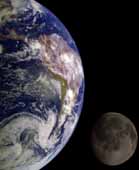|


The Moon has fascinated mankind throughout the ages. By simply
viewing with the naked eye, one can discern two major types of terrain: relatively bright highlands and darker plains. By
the middle of the 17th century, Galileo and other early astronomers made telescopic observations, noting an almost endless
overlapping of craters. It has also been known for more than a century that the Moon is less dense than the Earth. Although
a certain amount of information was ascertained about the Moon before the space age, this new era has revealed many secrets
barely imaginable before that time. Current knowledge of the Moon is greater than for any other solar system object except
Earth. This lends to a greater understanding of geologic processes and further appreciation of the complexity of terrestrial
planets.
On July 20, 1969, Neil Armstrong became
the first man to step onto the surface of the Moon. He was followed by Edwin Aldrin, both of the Apollo 11 mission. They and
other moon walkers experienced the effects of no atmosphere. Radio communications were used because sound waves can only be
heard by travelling through the medium of air. The lunar sky is always black because diffraction of light requires an atmosphere.
The astronauts also experienced gravitational differences. The moon's gravity is one-sixth that of the Earth's; a man who weighs
180 lbf (pound-force) on Earth weighs only 30 lbf on the Moon. (The equivalent metric weight (or force) is the Newton, where
4.45 Newtons equal one pound-force.)
The Moon is 384,403 kilometers (238,857 miles) distant from
the Earth. Its diameter is 3,476 kilometers (2,160 miles). Both the rotation of the Moon and its revolution around Earth takes
27 days, 7 hours, and 43 minutes. This synchronous rotation is caused by an unsymmetrical distribution of mass in the Moon,
which has allowed Earth's gravity to keep one lunar hemisphere permanently turned toward Earth. Optical librations have been
observed telescopically since the mid-17th century. Very small but real librations (maximum about 0°.04) are caused by the
effect of the Sun's gravity and the eccentricity of Earth's orbit, perturbing the Moon's orbit and allowing cyclical preponderances
of torque in both east-west and north-south directions.
The Moon was heavily bombarded early in its history, which caused many of the original rocks
of the ancient crust to be thoroughly mixed, melted, buried, or obliterated. Meteoritic impacts brought a variety of "exotic"
rocks to the Moon so that samples obtained from only 9 locations produced many different rock types for study. The impacts
also exposed Moon rocks of great depth and distributed their fragments laterally away from their places of origin, making
them more accessible. The underlying crust was also thinned and cracked, allowing molten basalt from the interior to reach
the surface. Because the Moon has neither an atmosphere nor any water, the components in the soils do not weather chemically
as they would on Earth. Rocks more than 4 billion years old still exist there, yielding information about the early history
of the solar system that is unavailable on Earth. Geological activity on the Moon consists of occasional large impacts and
the continued formation of the regolith. It is thus considered geologically dead. With such an active early history of bombardment
and a relatively abrupt end of heavy impact activity, the Moon is considered fossilized in time.
|

